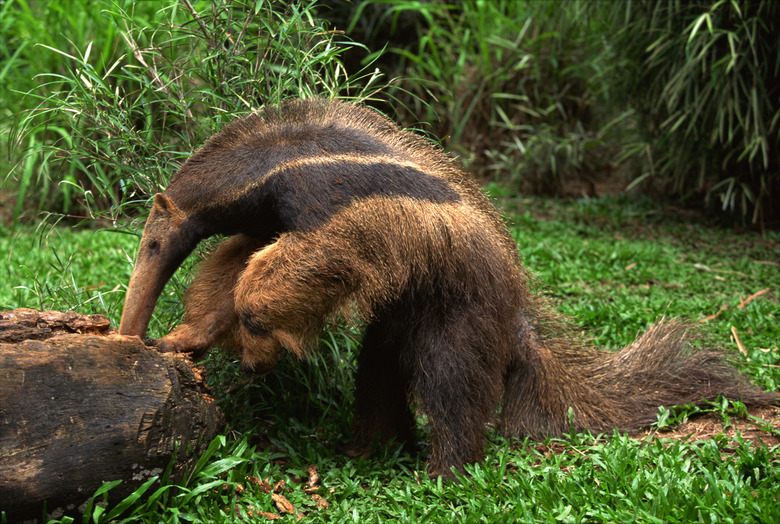Five Physical Adaptations For Anteaters
Four species of anteaters can be found living in their natural tropical forest, savanna and grassland habitats in South and Central America. Anteaters are highly adapted to their habitats and diet. Although it is necessary for the anteater to eat a large number of ants and termites to gain enough energy, it never consumes the entire population of an ant or termite nest. This allows the insect populations to continue and ensures that food sources continue to be replenished.
Nose
Nose
Anteaters have an acute sense of smell which helps them to locate anthills and even allows them to tell what type of ant is inside it. The wet, black nose is located on the end of the anteater's long, pointed snout. The position of the nose is useful for locating food and it also helps the anteater to hold its nose above the surface of the water when swimming.
Tongue
Tongue
The anteater has an extremely long tongue that can reach distances of up to 2 feet beyond the end of its snout. Anteater tongues are covered in tiny barbs and thick, sticky saliva. The barbs and saliva help the anteater to collect as many ants as possible on its tongue. A giant anteater is capable of eating around 30,000 ants in a single day thanks to highly-adapted tongue that can be projected and withdrawn at a rate of around 150 times per minute.
Digestive System
Digestive System
The anteater's mouth is narrow, tube-like and toothless. This mouth allows its long, thin tongue to flick in and out quickly and efficiently. Anteaters have specialized stomachs that grind up ants with powerful muscles and dissolve them in strong acids. The anteater's specialized stomach prevents the animal from needing teeth to break down its food and allows large amounts of food to be consumed by swallowing it whole without chewing.
Claws
Claws
Sharp, long claws protrude from the three middle toes on each of the anteater's feet. These strong claws can be used to break open the termite mounds and ant hills that it feeds from. When the anteater is climbing trees, long claws help it to grip onto tree trunks and branches. Anteaters also use their impressive claws to swipe at predators such as big cats when they are threatened. Anteaters prevent their useful claws from being worn down by walking on the outer sides of their feet, holding the claws and the middle parts of their soles above the ground.
Tail
Tail
Anteaters have strong, long tails that can measure up to 3 feet in length, depending on species. The tail can be used as an additional limb to help support the anteater when standing on its two back legs. Anteaters can also use their tails to hold onto branches when moving through trees. Part of the tail has no hair, allowing the anteater to achieve a better grip on branches. Most of the tail, however, is covered in long hair. When temperatures drop, anteaters gain extra insulation by bending their hairy tails around to cover their furry bodies.
Cite This Article
MLA
Ames, Hayley. "Five Physical Adaptations For Anteaters" sciencing.com, https://www.sciencing.com/five-physical-adaptations-anteaters-10023782/. 24 April 2017.
APA
Ames, Hayley. (2017, April 24). Five Physical Adaptations For Anteaters. sciencing.com. Retrieved from https://www.sciencing.com/five-physical-adaptations-anteaters-10023782/
Chicago
Ames, Hayley. Five Physical Adaptations For Anteaters last modified March 24, 2022. https://www.sciencing.com/five-physical-adaptations-anteaters-10023782/
